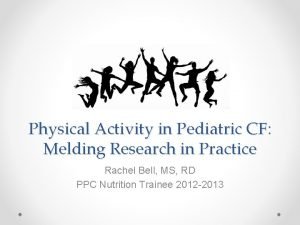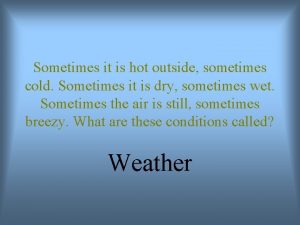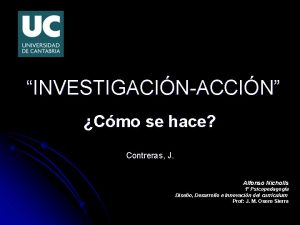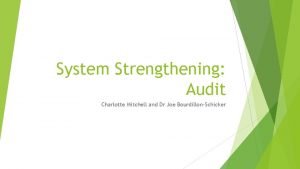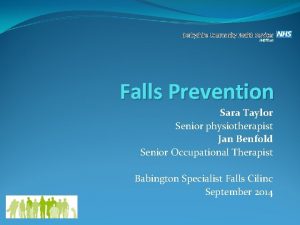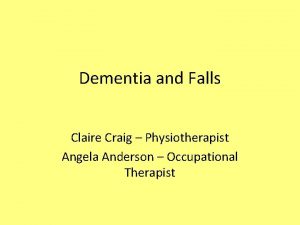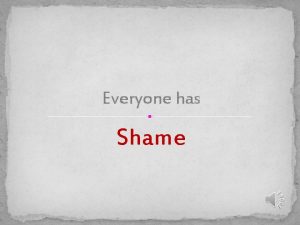Falls Charlotte Nicholls Physiotherapist Everyone falls sometimes we












- Slides: 12

Falls Charlotte Nicholls Physiotherapist

Everyone falls sometimes, we all have stumbles and trips It can be embarrassing, but no more than that

Falls become a problem when they: • Occur doing necessary and day to day activities i. e. getting washed and dressed • Induce a fear of falling – people may limit their activity due to fear and can then lose their independence • Keep happening – recurrent falls • Cause injury – fractures, sprains, bleeds

Further Information • As we age and become more frail we are more likely to fall • Falls are NOT an inevitable part of aging • At least 1/3 of over 65’s living in the community fall each year • The majority of fractures in older people occur as a result of a fall from standing height

• Fractures commonly affect the wrist, pelvis, upper arm or hip • 1 in 2 women, and 1 in 6 men experience a fragility fracture in later life • These fractures are often painful and disabling • Hip fractures are the most serious consequence

Some reasons why we fall Problems with our walking pattern Poor balance Weak muscles Cognitive impairment i. e. dementia Taking multiple medications Visual impairment Fainting/dizziness Acute illness Continence problems

There is some good news! We can reduce our risk of falling!!!

Exercise There is lots of evidence to show that specific and targeted exercise reduces the risk of falling, and the number of falls. • Lower limb strengthening exercises • Balance exercises • Resistance training Tai Chi is also shown to reduce the risk of falling

Environment There is strong evidence to show that a full home assessment completed by an Occupational Therapist is effective at reducing the number and risk of falls. They can look at; • Bed and toilet transfer assessment • Rugs and trip hazards • Obstacles • Poor lighting • Grab handles • Seating adaptations • Bathroom adaptations • Suitable equipment provision

Other factors Multiple medications • Some medications have side effects – discuss with your GP or CNS if you have concerns Continence • Can effect men and women • Discuss with GP regarding any incontinence • Can be improved with Physiotherapy/medications/lifestyle changes

Other factors Visual Impairment • Are glasses the correct prescription? • First cataract surgery significantly reduces the risk and number of falls Feet and footwear • Good fitting slippers and shoes are important to reduce falls risk • Look after your feet with attention to nail length – if you can’t reach your feet ask a family member or ask for a referral to chiropody or podiatry

Further information https: //www. nhs. uk/conditions/Falls/ https: //www. csp. org. uk/conditions/fallsfractures https: //www. rcot. co. uk/about-occupationaltherapy/living-well-care-homes-2019/getting -active https: //www. ageuk. org. uk/informationadvice/health-wellbeing/exercise/fallsprevention/
 Everyone falls at work sometimes
Everyone falls at work sometimes My perspective
My perspective Good afternoon to you all
Good afternoon to you all Sometimes you win some
Sometimes you win some Sometimes sweet sometimes sour
Sometimes sweet sometimes sour Sometimes cold sometimes hot
Sometimes cold sometimes hot Sometimes you win some
Sometimes you win some Nicholls mission & core competencies
Nicholls mission & core competencies Shopping trolley poem
Shopping trolley poem Alfonso nicholls
Alfonso nicholls Charlotte bronte father
Charlotte bronte father Dr charlotte mitchell
Dr charlotte mitchell Lucie kovaříková matka
Lucie kovaříková matka

